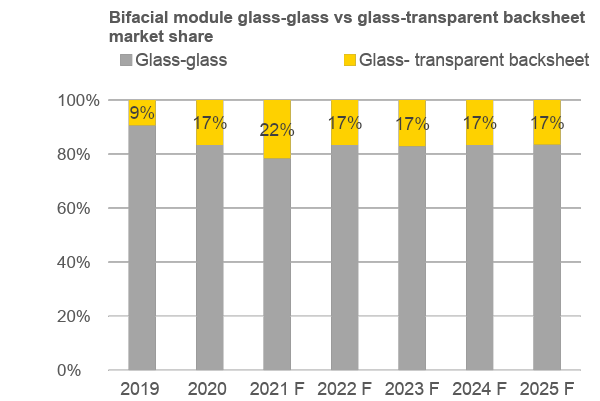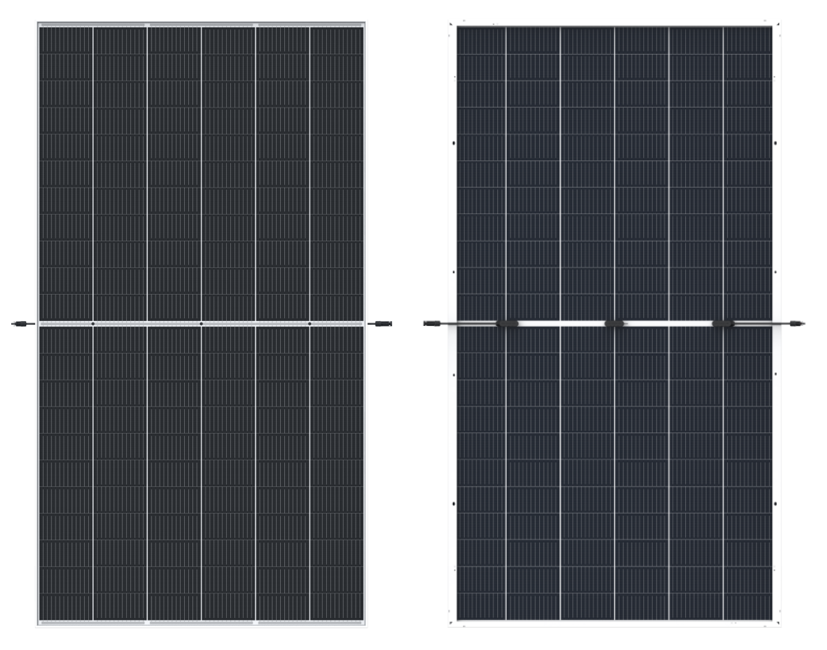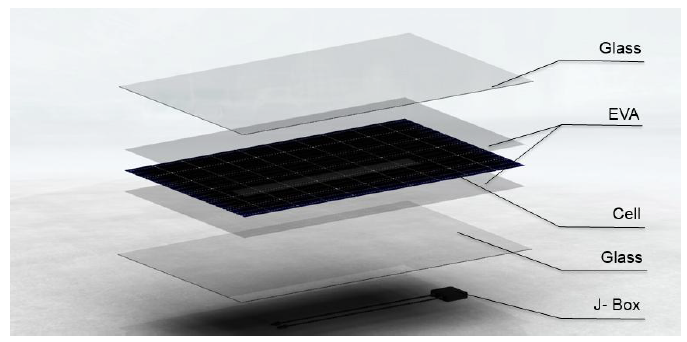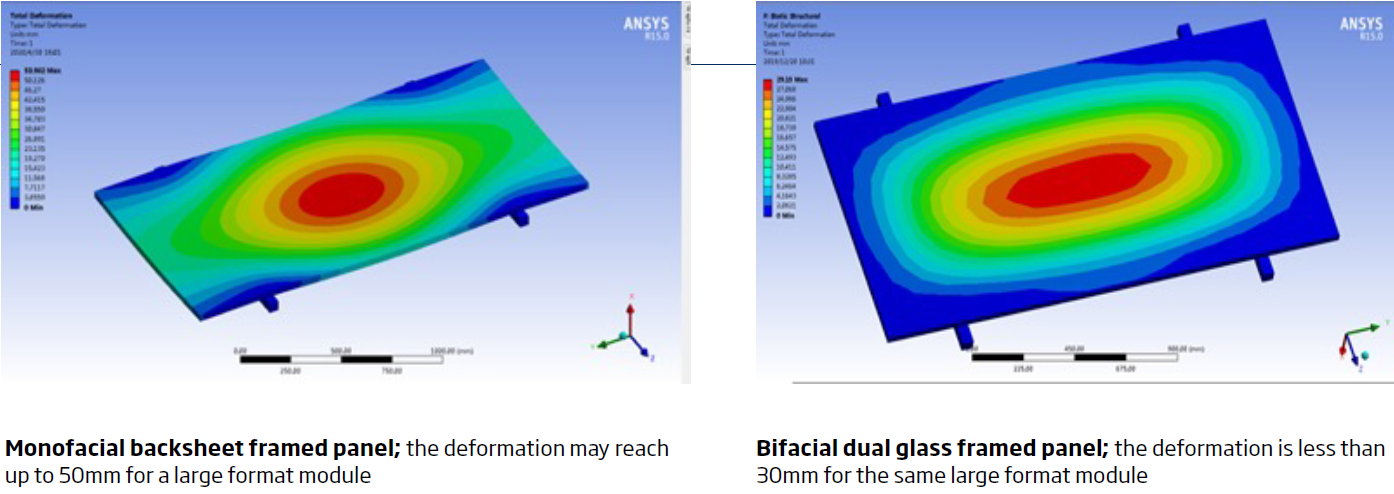Dual-glass vs glass-backsheet: The winning formula for bifacial modules
- 22/10/19
- Reliability,Customer Value,Innovation and Advance,Industry News,Panel Talk and Technology
Bifacial glass technology is the preferred material among manufacturers for the rear side cover of the modules. Some key advantages of the glass-glass structure are:
- Better light transmittance
- Less degradation
- Zero risk of water permeability
- Weather ability
- Corrosion resistance
- Abrasion resistance
Glass-glass modules can also be frameless, which helps eliminate the cost of an extruded aluminum frame. However, glass-glass models with frames have a lower risk of breakage. As a result, most glass-glass modules come with frames in place.
Compared with standard glass backsheet technology, framed modules with two layers of glass are heavier. Therefore, transparent backsheets are a solution for a lighter bifacial module. A more lightweight module means less cost on transportation, labor, and trackers whenever applicable.
Due to their better reliability, glass-glass bifacial configurations have a larger portion of the worldwide bifacial module market share. Glass shortages, weight concerns for larger format modules, and decreasing prices for transparent backsheets have caused some manufacturers to switch to a glass-transparent backsheet structure. However, bifacial product forecasts this year show glass-transparent backsheet as representing only 20% of the total market share. Projections also show these shares reducing even more in the following years once the main components shortage is resolved, as seen in this figure:

Bifacial modules: Global market share of glass-glass vs glass-transparent backsheet
Trina Solar bet on glass-glass configuration for the bifacial module
With the rapid development of the PV industry, leading companies, research institutes, and institutions of higher education are devoted to module design and process-specific production optimization to reduce module cost and improve module quality. The life cycle of PV modules in general is primarily dependent on backsheets, and their current life expectancy is 25–30 years.
With customers' increasingly urgent need for high quality, high power, long-life products, breakthroughs in the current module structure can be challenging. However, Trina Solar has made such a breakthrough by abandoning the backsheet and developing the brand-new dual glass module.

Trina Solar Vertex TSM-DEG21C.20 (670 W) framed dual-glass bifacial module
Our dual glass modules use the same internal circuit connection as a traditional glass-backsheet module but feature heat-strengthened glass on both sides. We produce the back glass with a unique drilling technique that ensures the reliability of both the junction box installation and the module. Compared with traditional modules, our dual glass modules replace the organic backsheet with inorganic back glass to extend life expectancy.
From this point of view, the structural design of our dual-glass modules overcomes problems such as the outdoor degradation-induced material aging and the power attenuation that frequently affects traditional backsheets. In addition, our design avoids distinctive weak points in thin-film modules, such as low efficiency and high vulnerability. Moreover, the thin-film module can only use annealed glass as front glass, resulting in cracks during production and operation due to insufficient strength. This also affects its efficiency.

Dual glass module structure (layers)
Trina Solar was the first company to obtain IEC61215/IEC61730-1 and 2, UL61730, IEC 1500 V/UL100V, UL, and TUV RH Class A fire certifications for a dual glass product. Furthermore, our tested modules passed 192h PID resistance tests under 85% RH 85°C and 1500V system voltage, having shown excellent resistance to PID and snail trails.
Our analysis identified the following benefits for glass-glass configuration bifacial modules:
Resistance to salt spray, acids and alkalis
The polymer backsheet that traditional modules use is made from plastic with poor resistance to acid and corrosion. Prolonged exposure to air may bring about yellowing, cracking, degradation and chalking, etc. In contrast, the glass found in our dual glass modules is a kind of inorganic material with relatively superior weather resistance, which considerably improves the module's reliability.
Zero moisture penetration
Normally, moisture could penetrate traditional polymer backsheet modules. Long-term moisture penetration may cause various degrees of damage to cells. However, since moisture cannot penetrate glass, our glass design can better protect cells and extend their life expectancy.
Comprehensively reduce invisible cell cracking
Our dual-glass structure constitutes a sandwich-like design with a strong resistance to shock and vibration that ensures module safety during production, transport, and installation and prevents new invisible cell cracking.
More excellent mechanical load ability
Thanks to improvements in module stiffness and the better support of dual-glass design, the deformation of our dual-glass modules is much lower than that of traditional modules with frames under the same mechanical load, according to the FEM simulation analysis.

Module deformation (FEM simulation) for dual glass vs glass-backsheet configuration
For more, read Trina Solar’s Ultimate Guidebook for Bifacial System Design
This blog post is original content from Trina Solar’s free Ultimate Guidebook for Bifacial System Design. To learn more about key factors to consider when planning solar power stations with bifacial modules, and the benefits these modules can bring to any solar project, download this valuable resource today!


